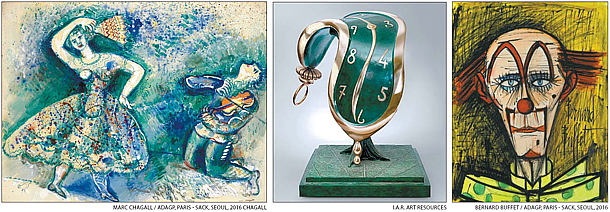Chagall, Dali and Buffet on display at Hangaram

From left, “La danse” (1928) painted by Marc Chagall; “Dance of Time II” (1979) by Salvador Dali; and “Clown a la a pois” (1978) by Bernard Buffet.[MARC CHAGAL / ADAGP - SACK, SEOUL, 2016 CHAGALL,I.A.R. ART RESOURCES,BERNARD BUFFET / ADAGP - SACK, PARIS 2016]
Unlike many of the towering geniuses of the 19th century, these three masters acquired both wealth and fame in their lifetimes and yet were dogged by misfortunes that they each, in their way, sublimated into the worlds they depicted in their art forms.
Their lives and works are now being exhibited in Seoul Arts Center’s Hangaram Art Museum in Seocho District, southern Seoul.
This is the first time the works of these three artists have been displayed in one place in Korea.
The exhibition will focus on their biographies and the various ways in which they tried to negotiate and express the hardships of daily life through their art.
Marc Chagall was born in Russia and later became a French citizen. A Jewish artist, he experienced much discrimination during his lifetime. Unlike non-Jewish French citizens, his movements were monitored and controlled and he was required to carry a license to travel to different parts of the country. He later fled to the United States during the Nazi occupation of France.
But despite these hardships, Chagall’s art is known for its vivid use of color and uplifting spirit.
It is difficult to discuss his place in the history of art, however. Chagall practiced many different styles over the course of his lifetime, making it difficult to pin him down as belonging to any single school of painting.
“The images of roosters, a little town, a woman and a musical instrument appear in almost every Chagall painting,” said Won Chun-bo, the exhibition manager. “The rooster signifies Jewishness, the little town is his birthplace in Russia, the woman varies but mostly symbolizes his wife, Bella Rosenfeld, and the musical instrument is a klezmer, a kind of fiddle used in Jewish folk music.”
Won added, “These elements appear frequently in his works and remind him of his identity.”
Along with their brilliant colors, Chagall’s paintings are noted for their fantastic and often almost supernatural atmosphere, and yet throughout his life Chagall himself insisted all his works were based on real experiences.
Having been ostracized all his life, he had little interest in his art being seen as strange or unreal.
In contrast to Chagall’s professed normality, Dali’s name goes hand-in-hand with the eccentric and the surreal. His work cannot be grasped at a glance and upon careful study it may even appear frivolous, but those who take the time to understand his art are generously rewarded.
For example, his famous sculpture, “Dance of Time II,” explores the elastic subjectivity of time. Dali viewed time as a flexible concept by which moments may ebb or flicker and not as something exact and fixed. To express this, he depicted a clock warped and melting away.
Critics attacked his art as being overly commercial and outside the realm of the noble world of fine art.
The commercial nature of Dali’s art made him increasingly famous, but it also cost him his relationship with several of his peers.
“He liked to give people a shock, something out of the ordinary,” Won said. “Even though he was harshly criticized by other artists, he chose to walk toward advertisement and the the film industry.”
Such criticism was also made of expressionist Bernard Buffet.
Buffet never received a formal education in art. But he had his own sense of aesthetics to which he stayed true while tastes and trends shifted around him. Two characteristic Buffet elements are the use of thick lines and a minimal range of color.
Buffet was financially very successful as a young man but he was not regarded as a serious artist for many years.
Nevertheless, he continued with his art and eventually amassed a collection of over 8,000 works.
“Clown a la cravate a pois” (1978) features the face of a clown with a stiff mouth and a weary look in his eyes. This is one of Buffet’s best-known works.
The exhibition links the works of these three artists and illuminates the ways in which their daily lives are presented in their work, sometimes in ways that are obvious and sometimes in ways that sneak up on you and only become apparent after you’ve walked away.
The exhibition runs through Sept. 25. The museum is closed the last Monday of every month. Admission is 13,000 won ($11.32) for adults. On weekdays beginning at 2 p.m. and 5 p.m., a docent will give guided tours. For further details, visit www.sac.or.kr.
BY KIM HYANG-MIN [kim.hyangmin@joongang.co.kr]










with the Korea JoongAng Daily
To write comments, please log in to one of the accounts.
Standards Board Policy (0/250자)